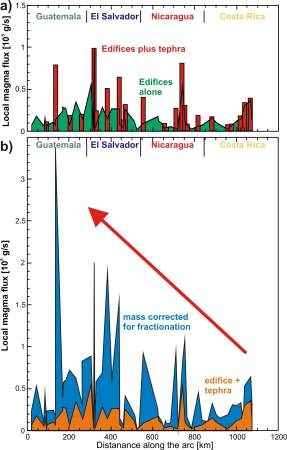 Web Content Display Web Content Display
Magma production ratesWe determined the long-term magma production rates along the CAVA accounting for volcano edifice and widespread-tephra volumes as well as fractionated intrusive masses. Magma production rates vary systematically along the CAVA with peak values reached at northern El Salvador. There is a negative correlation with slab dips >50° as long as crustal thickness is low and approximately constant (northern Costa Rica through El Salvador); there may be a positive correlation with slab dips <50° under thick crust across Guatemala. In addition, there is a positive correlation with the intensity of bend faulting on the outer rise of the Cocos plate suggesting that pre-subduction hydration of the plate may have controlled magma production. These different relationships with slab dip probably reflect changes in slab-fluid partitioning between mantle wedge and subduction channel, depth of slab dehydration, and length of the melting column in the mantle wedge.
Figure 1: a) Magma mass fluxes from CAVA volcanoes averaged over volcano age and based on edifice volumes (green) and on edifice plus tephra volumes (red). b) Comparison of the extrusive mass fluxes (derived from edifice plus tephra volumes) with total magma fluxes including fractionated cumulate masses trapped in the crust (for differentiation above 50 wt% SiO2). The red arrow shows the increase of peak total magma fluxes from Costa Rica to Guatemala. |
 Events Events
Kieler Wissenschaftler fühlen den 'Puls der Erde' Wie funktioniert die Recyclingmaschine der Erde?Nach elf Jahren endet der Kieler Sonderforschungsbereich 574 zu Subduktionszonen Final colloquium of SFB 574 Teilprojekt ÖffentlichkeitsarbeitMEERESFORSCHUNG FÜR MICH UND DICH |
|
©SFB574 // Wischhofstrasse 1-3 // D-24148 Kiel // T. +49 (0)431 600 1413 // elange [AT] geomar.de






